Related Research Articles

The Hughes H-4 Hercules is a prototype strategic airlift flying boat designed and built by the Hughes Aircraft Company. Intended as a transatlantic flight transport for use during World War II, it was not completed in time to be used in the war. The aircraft made only one brief flight, on November 2, 1947, and the project never advanced beyond the single example produced.

Glenn Hammond Curtiss was an American aviation and motorcycling pioneer, and a founder of the U.S. aircraft industry. He began his career as a bicycle racer and builder before moving on to motorcycles. As early as 1904, he began to manufacture engines for airships. In 1908, Curtiss joined the Aerial Experiment Association, a pioneering research group, founded by Alexander Graham Bell at Beinn Bhreagh, Nova Scotia, to build flying machines.

The Convair F2Y Sea Dart was an American seaplane fighter aircraft that rode on twin hydro-skis during takeoff and landing. It flew only as a prototype, and never entered mass production. It is the only seaplane to have exceeded the speed of sound.

The AD Flying Boat was designed by the British Admiralty's Air Department to serve as a patrol aircraft that could operate in conjunction with Royal Navy warships. Intended for use during the First World War, production of the aircraft was terminated as the end of the war came into sight, and the type saw little operational use. A number were repurchased after the end of the war by Supermarine Aviation and rebuilt as civil transports, becoming known as the Supermarine Channel.
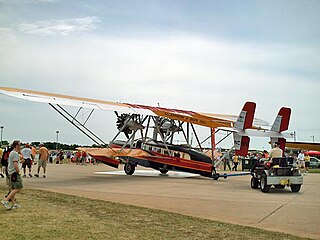
The Sikorsky S-38 was an American twin-engined ten-seat sesquiplane amphibious aircraft. It was Sikorsky's first widely produced amphibious flying boat, serving successfully for Pan American Airways and the United States military.

The Sikorsky S-40 was an American amphibious flying boat built by Sikorsky in the early 1930s for Pan American Airways.
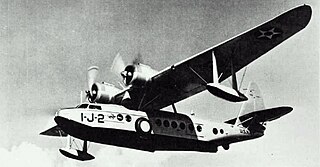
The Sikorsky S-43 was a 1930s American twin-engine amphibious flying boat monoplane produced by Sikorsky Aircraft.

The Sikorsky S-39 is an American light amphibious aircraft produced by Sikorsky Aircraft during the early 1930s. The S-39 was a smaller, single-engine version of the S-38.
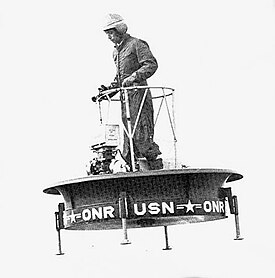
The Hiller VZ-1 Pawnee was a unique direct-lift rotor aircraft, using contra-rotating ducted fans for lift inside a platform upon which the single pilot shifted body weight for directional control. The platform was developed starting in 1953 under an Office of Naval Research (ONR) contract to Hiller Aircraft, and flew successfully beginning in 1955.

The Hall XPTBH was a prototype American twin-engined seaplane, submitted to the United States Navy by the Hall Aluminum Aircraft Corporation in response to a 1934 specification for new bomber and scout aircraft. Constructed in an innovative fashion that made extensive use of aluminum, the XPTBH proved successful in flight testing, but failed to win favor with the U.S. Navy. No production contract was awarded, and the single aircraft built served in experimental duties before its destruction in a hurricane during 1938.
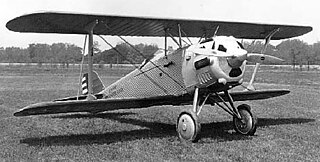
The XP-13 Viper was a prototype biplane fighter aircraft designed by the American company Thomas-Morse Aircraft Corporation. The airplane was delivered to the United States Army in 1929, but they did not adopt it.

The Savoia-Marchetti SM.62 was an Italian single-engine maritime patrol flying boat produced from 1926. It served with the Regia Aeronautica and with a number of foreign users, and was licence-produced in Spain and the Soviet Union. Some of the Spanish aircraft were still in service during the Spanish Civil War

The Consolidated P2Y was an American flying boat maritime patrol aircraft. The plane was a parasol monoplane with a fabric-covered wing and aluminum hull.

The Supermarine Air Yacht was a British luxury passenger-carrying flying boat. It was designed by Supermarine's chief designer R. J. Mitchell and built in Woolston, Southampton in 1929. It was commissioned by the brewing magnate Ernest Guinness, and was the first British flying yacht built to the order of a private owner. Only one machine was built.

The Supermarine Nanok was a British three-engined biplane flying boat built by Supermarine. Built to meet a Royal Danish Navy requirement, the single prototype was rebuilt as a private air yacht and renamed the Supermarine Solent.
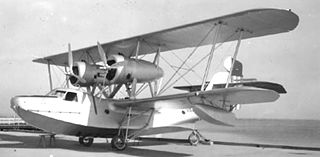
The Hall PH was an American flying boat of the 1930s. It was a twin-engined biplane, developed from the Naval Aircraft Factory PN and could hence trace its lineage back to the Felixstowe flying boats of World War I. The PH was purchased in small numbers by the United States Navy and the United States Coast Guard. It remained in service with the Coast Guard until 1944, being used for anti-submarine and search and rescue duties.

The Loening S-1 Flying Yacht, also called the Loening Model 23, was an early light monoplane flying boat designed in the United States by Grover Loening in the early 1920s. The aircraft won the 1921 Collier Trophy.

The Hall XP2H-1 was an American prototype four-engined biplane flying boat of the 1930s. Intended as an experimental very-long-range maritime patrol aircraft, a single example was built. The XP2H-1 was the largest four engine biplane aircraft ever procured by the US Navy.

The Supermarine Channel was a modified version of the AD Flying Boat, purchased by Supermarine from the British Air Ministry and modified for the civil market with the intention of beginning regular air flights across the English Channel. The aircraft were given airworthiness certificates in July 1919. The Mark I version, later called the Channel I, was powered with a 160 horsepower (120 kW) Beardmore engine; a variant designated as Channel II was fitted with a 240 horsepower (180 kW) Armstrong Siddeley Puma engine. Designed by Supermarine to accommodate up to four passengers, the company produced a series of interchangeable interiors that could be used at short notice, which enabled the Channel to be used as a fighter or for training purposes.
The Aeromarine AMC was the first American all-metal hulled commercial flying boat.
References
- ↑ Eckland, K.O. (15 August 2008). "American airplanes: H". Aerofiles.com. Retrieved 13 November 2014.